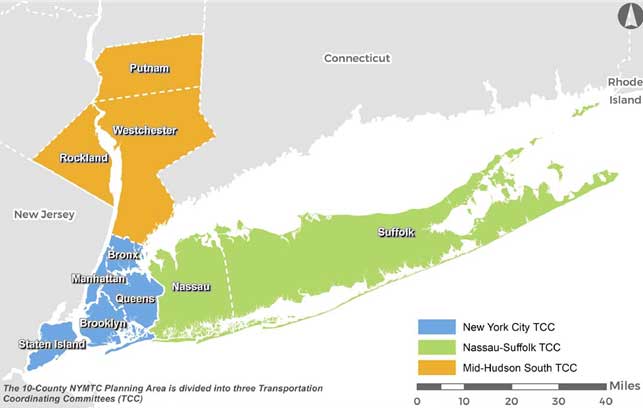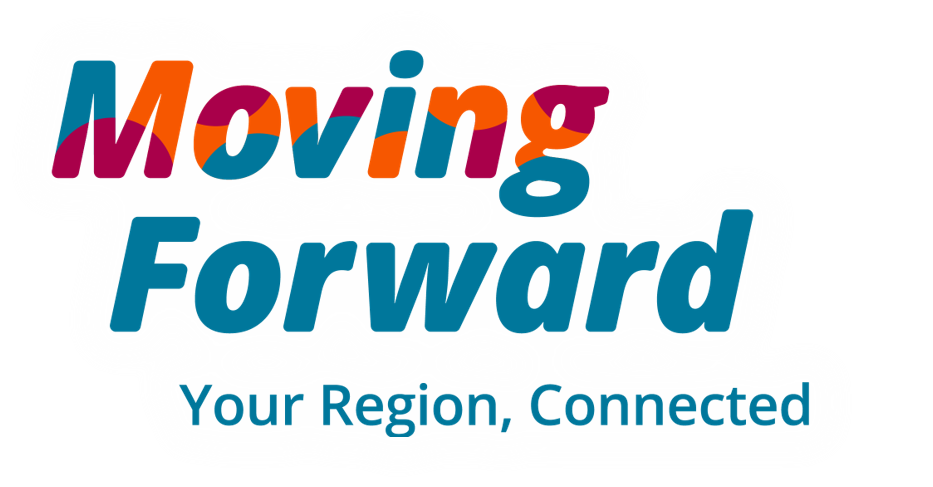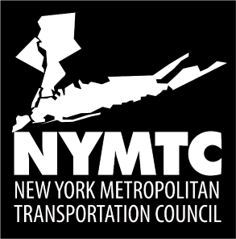
Our Shared Vision for Regional Mobility
Our Region's Needs
Whether in Midtown Manhattan, Mount Vernon, Montebello, Mahopac, Mineola or Montauk, we all rely on the country’s most robust transportation network to get us where we need to go and to make available the things that we need. Every day, millions of people are on the move in this multi-state metropolitan region—commuting to their jobs, dropping children off at school, visiting family and friends, racing to the airport to catch a flight, or just going about everyday routines. Every day, millions of tons of goods are on the move, being delivered at residences; moving to and from intermodal centers, distribution centers and warehouses; and traveling through the region to and from adjacent areas. And while different communities may move differently across our vast region, we all collectively share our need to get around easily and safely. Read Chapter 1: NYMTC's Shared Vision for Regional Mobility. (Open in a new window)
Our Vision
The members of the New York Metropolitan Transportation Council (NYMTC) recognize that mobility—the ability of people and goods to move easily and safely to, from and between locations—is crucial to the lives of people of all abilities who live in, work in, or visit the NYMTC planning region. Therefore, we aspire to ensure that the mobility provided by our transportation systems reaches everyone in a sustainable, healthy, and equitable manner; to invest efficiently for these transportation needs; and to respond effectively to the transportation challenges of tomorrow.
As NYMTC, we will pursue our shared vision through the metropolitan transportation planning process built from this Plan. To do this, we envision a transportation system that:
Who Are We?
Federal legislation requires that any urbanized area with a population greater than 50,000 must have a metropolitan planning organization (MPO) to plan for and make decisions on the use of federal transportation funding. MPOs ensure that existing and future expenditures for transportation projects and programs are based on a continuing, cooperative, and comprehensive planning process. Among other functions/requirements, MPOs cooperate with state and public transportation operators to program federal funds for eligible transportation projects.
As the MPO for New York City, Long Island, and the Lower Hudson Valley, NYMTC serves as a collaborative planning forum for the five boroughs of New York City; Nassau and Suffolk counties on Long Island; and Putnam, Rockland and Westchester counties in the Lower Hudson Valley; the State of New York; and the Metropolitan Transportation Authority to undertake the federally mandated planning process and access federal funding for transportation projects. NYMTC’s regional council is advised by the Port Authority of New York and New Jersey, New Jersey Transit, and the North Jersey Transportation Planning Authority, as well New York State’s Department of Environmental Conservation, the U.S. Environmental Protection Agency, and two modal administrations of the U.S. Department of Transportation: the Federal Highway Administration (FHWA) and the Federal Transit Administration.

As NYMTC, our planning efforts help ensure that the region is prepared to obtain the maximum federal funds available to achieve the shared regional goals of our member agencies for the future of the transportation system. As NYMTC, we are a forum for collaborative planning from a regional perspective. We facilitate informed decision-making among our members by providing sound technical analysis and forecasts to focus the collective planning activities of NYMTC’s members to achieve a shared regional vision.
Guiding Principles
- We will consider the needs of all users in NYMTC’s planning area throughout the planning process.
- We will make the best use of federal resources for the regional transportation system and increase them where practical, while leveraging local resources as efficiently and effectively as possible.
- We will monitor the performance of the regional transportation system as a means of prioritizing improvements and investments.
- We will support multi-agency approaches that enhance the integration of independently operated components of the regional transportation system.
- We will engage the public and community stakeholders.
- We will harness technological advancements to improve our transportation system.
Our Objectives in Pursuing These Goals
Objectives:
- Ensure that investments in existing physical assets protect the safety of, among others, passengers and freight systems.
- Promote safe streets and intersections.
- Keep the transportation system secure from threats.
- Coordinate safety management, training and education across jurisdictional borders.
- Improve the safety and security of system operations.
Objectives:
- Rebuild/replace and modernize the assets that comprise the region's vast transportation infrastructure for passengers and freight.
- Improve first- and last-mile access to transit.
- Provide more frequent and reliable transit service.
- Improve accessibility to the transportation system for users of all abilities.
- Invest in improving the integration of the multimodal transit network.
- Improve the integration of freight modes and facilities.
- Invest in collection and sharing of quality transportation data.
- Promote equitable transportation and workplace access opportunities for all populations regardless of age, ability, race, ethnicity, or income.
Objectives:
- Invest in system capacity to satisfy demand and relieve overcrowding, with an emphasis on core markets and activity centers.
- Expand the reach of the system to underserved communities and emerging markets, addressing passenger transportation as well as access to goods and freight services.
- Encourage walking and biking, transit-oriented development, Complete Streets, parking and curb management, and other long-term sustainable land use strategies that support passenger and goods movement.
- Modernize local freight networks to efficiently plan for growth in volume of and change in product deliveries.
- Incorporate emerging and innovative transportation services and tools into efficient network design.
Objectives:
- Encourage alternatives to single-occupant vehicle trips.
- Encourage lower-emissions alternatives to trucking.
- Modernize vehicle fleets to higher-standard and lower-emissions vehicles.
- Efficiently manage limited roadway capacity to mitigate congestion and vehicular emissions.
- Promote responsible environmental stewardship in transportation projects.
- Address unequal impacts of transportation emissions on communities.
Objectives:
- Protect and fortify major transportation assets.
- Continue to invest in sea level rise and climate change risk analyses for transportation assets.
- Improve regional coordination on emergency and long-term responses to systemwide climate impacts.
- Enhance the transportation network’s resiliency by increasing travel options and redundancies.

